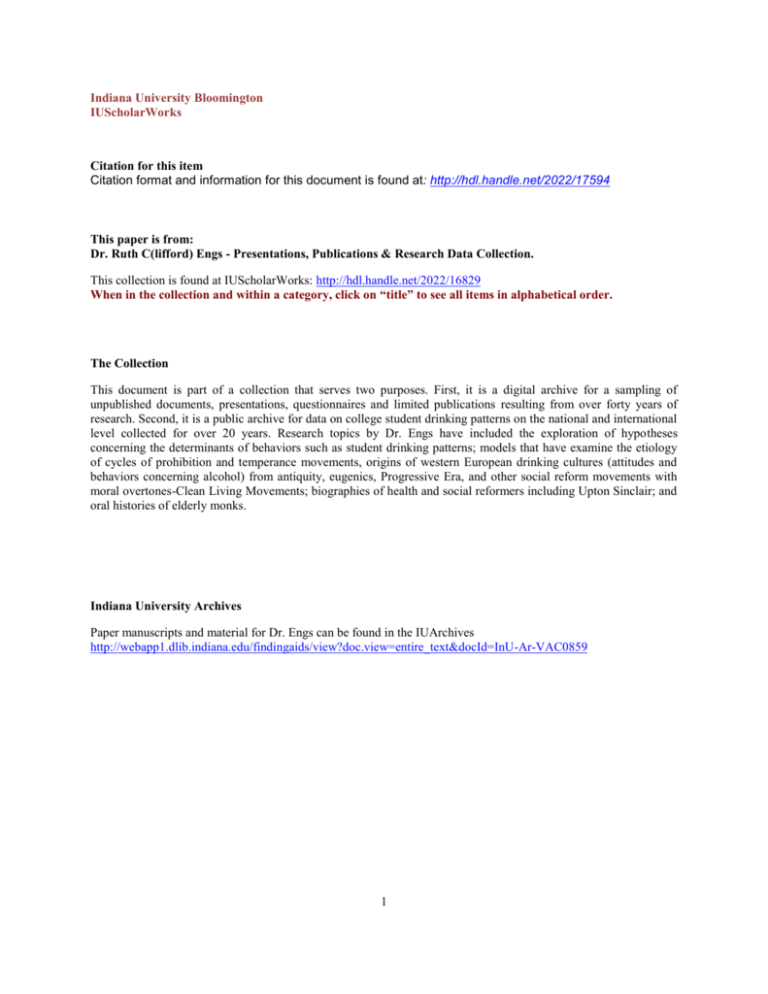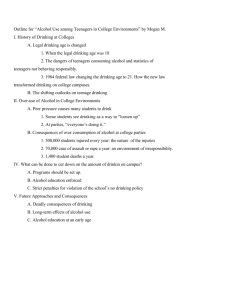Why the drinking age should - IUScholarWorks
advertisement

Indiana University Bloomington IUScholarWorks Citation for this item Citation format and information for this document is found at: http://hdl.handle.net/2022/17594 This paper is from: Dr. Ruth C(lifford) Engs - Presentations, Publications & Research Data Collection. This collection is found at IUScholarWorks: http://hdl.handle.net/2022/16829 When in the collection and within a category, click on “title” to see all items in alphabetical order. The Collection This document is part of a collection that serves two purposes. First, it is a digital archive for a sampling of unpublished documents, presentations, questionnaires and limited publications resulting from over forty years of research. Second, it is a public archive for data on college student drinking patterns on the national and international level collected for over 20 years. Research topics by Dr. Engs have included the exploration of hypotheses concerning the determinants of behaviors such as student drinking patterns; models that have examine the etiology of cycles of prohibition and temperance movements, origins of western European drinking cultures (attitudes and behaviors concerning alcohol) from antiquity, eugenics, Progressive Era, and other social reform movements with moral overtones-Clean Living Movements; biographies of health and social reformers including Upton Sinclair; and oral histories of elderly monks. Indiana University Archives Paper manuscripts and material for Dr. Engs can be found in the IUArchives http://webapp1.dlib.indiana.edu/findingaids/view?doc.view=entire_text&docId=InU-Ar-VAC0859 1 Why the drinking age should be lowered: An opinion based upon research Ruth C. Engs, Professor School of Public Health Indiana University Bloomington, In 47405 Adapted from: Alcohol Research and Health History Web Page, Indiana University. ©1997-2014, R. C. Engs, Bloomington, In Retrieved from IUScholarworks Repository: http://hdl.handle.net/2022/17594 The legal drinking age should be lowered to about 18 or 19 and young adults allowed to drink in controlled environments such as restaurants, taverns, pubs and official school and university functions. In these situations responsible drinking could be taught through role modeling and educational programs. Mature and sensible drinking behavior would be expected. This opinion is based upon research that I have been involved in for over thirty years concerning college age youth and the history of drinking in the United States and other cultures. Although the legal purchase age is 21 years of age, a majority of college students under this age consume alcohol but in an irresponsible manner. This is because drinking by these youth is seen as an enticing "forbidden fruit," a "badge of rebellion against authority" and a symbol of "adulthood." As a nation we have tried prohibition legislation twice in the past for controlling irresponsible drinking problems. This was during National Prohibition in the 1920s and state prohibition during the 1850s. These laws were finally repealed because they were unenforceable and because the backlash towards them caused other social problems. Today we are repeating history and making the same mistakes that occurred in the past. Prohibition did not work then and prohibition for young people under the age of 21 is not working now. The flaunting of the current laws is readily seen among university students. Those under the age of 21 are more likely to be heavy -- sometimes called "binge" -- drinkers (consuming over 5 drinks at least once a week). For example, 22% of all students under 21 compared to 18% over 21 years of age are heavy drinkers. Among drinkers only, 32% of under-age compared to 24% of legal age are heavy drinkers. Research from the early 1980s until the present has shown a continuous decrease, and then leveling off, in drinking and driving related variables which has parallel the nation's, and also university students, decrease in per capita consumption. However, these declines started in 1980 before the national 1987 law which mandated states to have 21 year old alcohol purchase laws. 2 The decrease in drinking and driving problems are the result of many factors and not just the rise in purchase age or the decreased per capita consumption. These include: education concerning drunk driving, designated driver programs, increased seat belt and air bag usage, safer automobiles, lower speed limits, free taxi services from drinking establishments, etc. While there has been a decrease in per capita consumption and motor vehicle crashes, unfortunately, during this same time period there was an INCREASE in other problems related to heavy and irresponsible drinking among college age youth. Most of these reported behaviors showed little change until AFTER the 21 year old law in 1987. For example from 1982 until 1987 about 46% of students reported "vomiting after drinking." This jumped to over 50% after the law change. Significant increase were also found for other variables: "cutting class after drinking" jumped from 9% to almost 12%; "missing class because of hangover" went from 26% to 28%; "getting lower grade because of drinking" rose from 5% to 7%; and "been in a fight after drinking" increased from 12% to 17%. All of these behaviors are indices of irresponsible drinking. This increase in abusive drinking behavior is due to "underground drinking" outside of adult supervision in student rooms, houses, and apartments where same age individuals congregate. The irresponsible behavior is exhibited because of lack of knowledge of responsible drinking behaviors, reactance motivation (rebellion against the law), or student sub-culture norms. Beginning in the first decade of the 21st century, distilled spirits [hard liquor] began to be the beverage of choice rather than beer among collegians. Previously beer had been the beverage of choice among students. A 2013 study of nursing students, for example, revealed that they consumed an average of 4.3 shots of liquor compared to 2.6 glasses of beer on a weekly basis. This change in beverage choice along with irresponsible drinking patterns among young collegians has led to increased incidences of alcohol toxicity - in some cases leading to death from alcohol poisoning. However, the percent of students who consume alcohol or are heavy or binge drinkers has been relatively stable for the past 30 years. Based upon the fact that our current prohibition laws are not working, the need for alternative approaches from the experience of other, and more ancient cultures, who do not have these problems need to be tried. Groups such as Italians, Greeks, Chinese and Jews, who have few drinking related problems, tend to share some common characteristics. Alcohol is neither seen as a poison or a magic potent, there is little or no social pressure to drink, irresponsible behavior is never tolerated, young people learn at home from their parents and from other adults how to handle alcohol in a responsible manner, there is societal consensus on what constitutes responsible drinking. Because the 21 year old drinking age law is not working, and is counterproductive, it behooves us as a nation to change our current prohibition law and to teach responsible drinking techniques for those who chose to consume alcoholic beverages. 3 Research articles that support this opinion are found in the Indiana University Repository at: https://scholarworks.iu.edu/dspace/handle/2022/17133/browse?type=title and https://scholarworks.iu.edu/dspace/handle/2022/17130/browse?type=title Some material here also used in: Engs, Ruth C. "Should the drinking age be lowered to 18 or 19." In Karen Scrivo, "Drinking on Campus," CQ Researcher 8 (March 20,1998):257. 4





